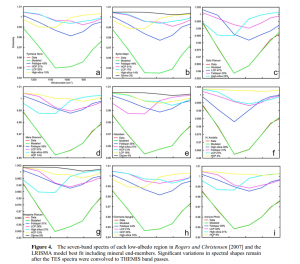
Abstract:We have developed a new method (least residual iterative spectral mixture analysis (LRISMA)) to semiquantitatively determine major rock‐forming minerals (feldspar, pyroxene, olivine, high‐silica phases, and quartz) with multispectral thermal infrared data. Sublibraries of minerals are generated from a master library of minerals based on prior knowledge to produce a suite of realistic mineral end‐member combinations to fit the target spectra. Mineral abundances that correspond to the least root‐mean‐square errors (best fit) generally agree best with previous petrographic studies of laboratory‐measured rock samples and thermal infrared hyperspectral analysis of materials on the surface of Mars, given the greatly reduced spectral range and resolution of Thermal Emission Imaging System (THEMIS) spectra. The accuracy and reproducibility of LRISMA is ~4–16% and ~5–20%, respectively, while the accuracy of petrographic and previous hyperspectral studies is ~5–15%. LRISMA can be applied to semiquantitatively refine the bulk surface mineralogy of small‐scale (~1 km2) geologic features with high‐quality THEMIS spectral data (high surface temperature: >260 K, low atmospheric opacity: total ice < 0.04 and total dust < 0.15) with the ultimate goal of better understanding regional geologic processes.
